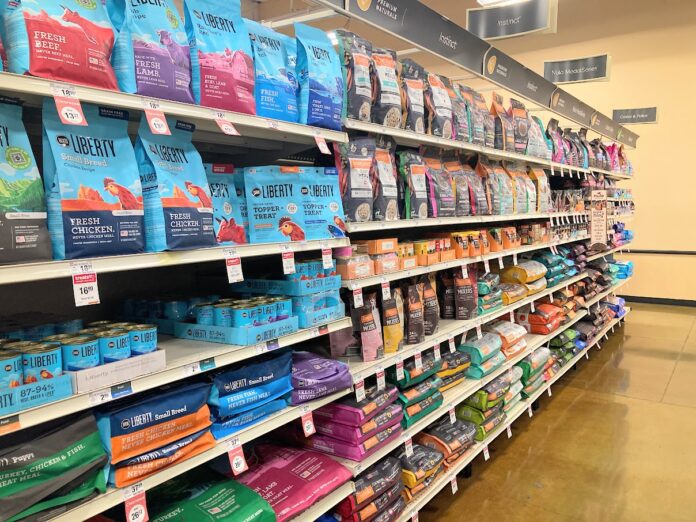Here’s what to look for in dog food and the criteria we use to identify good-quality dry dog foods.
1. Look for named animal protein sources at the top of the ingredients list.
Ingredients in pet food are listed in order of the weight of that ingredient in the formula, so whatever is at the top of the list is present in the food in the greatest amount.
We want to see animal protein sources, because animal proteins contain more of the amino acids that dogs need than plant-sourced proteins; the more completely a protein provides the amino acids that dogs need, the higher-quality that protein is considered to be.
We also want that animal protein source to be named – identified by species, whether it’s a meat, organ, or a meat meal (e.g., chicken, chicken liver, chicken meal).
When a fresh meat is first on the ingredient list, there should be a named animal-protein meal immediately or closely following the meat. Important note: When we use the phrase “meat meal,” we are always talking about a meal made from a named animal. If the ingredients list on a product label says “meat meal,” you have no idea what species of animal is in that meal. Only buy products with named meat meals – chicken meal, beef meal, pork meal, lamb meal, etc.
Meat meals are made through a process called rendering, whereby much of the moisture (and a lot of the fat) is removed from the meat. Meat meals are a highly concentrated source of protein. Pound for pound, meat meals provide much more protein at a lower cost than fresh meats. But fresh meats add appealing flavors and aromas to the food. Also, they get added to the food mixture just before the food is cooked; rendered meat meals have already been processed and will be twice-cooked by the time the food is extruded or baked (and some nutrients are depleted with each cooking process).
Fresh or frozen meat contains a lot of moisture (which is heavy), but not that much protein, so if meat is first on the list, it acts like a diluted protein source. That’s why we like to see another named source of animal protein appearing in the top two or three ingredients. We’re emphasizing animal proteins because some companies use fresh meats supported by plant proteins. To repeat ourselves, generally, plant proteins are less complete for dogs than animal proteins.
So, what’s best for healthy dog food: meat only, meat meal only, or both? We like both – but it depends on what works best for your dog and your budget.
2. Look for whole-food ingredients in dog food.
When vegetables, fruits, grains, and/or carbohydrate sources such as chickpeas or sweet potatoes are used, they should be whole. Ingredients that have already been processed, shipped, and stored before they are used in dog kibble will have lost quite a bit of their nutritive value before they are mixed with other ingredients and processed again (mixed with other ingredients and then either baked or extruded, dried, and coated).
3. Look for ingredients that are certified as organic, humanely raised, or sustainably farmed.
Companies will use wiggle words to lend the impression that they are using the best ingredients available. Certifications give these claims credibility in the best, healthy dog foods.
SUBSCRIBER ONLY: See Whole Dog Journal’s 2024 list of approved dry dog foods.
Signs of Low-Quality Dog Food: Traits and Ingredients to Avoid
The following are traits that we don’t want to see on a dog food label – undesirable attributes that indicate a lower-quality dog food:
- The lowest price you can find.
The cheapest foods contain the cheapest ingredients available to pet food manufacturers, and will not be healthy dog foods. While technically any food that’s labeled as “complete and balanced” is supposed to contain minimum amounts of the nutrients dogs need, with low-quality ingredients, there is no telling how bio-available the nutrients will be.
- Animal products that are not specified by species.
Meat meal, meat and bone meal, poultry meal, poultry by-product meal, animal fat, poultry fat: If you have a pet with a food intolerance or allergy, you have to know what you’re feeding him in order to identify the problematic ingredient.
- Animal by-products.
This includes meat by-products and poultry by-products, as well as meat by-product meal and poultry by-product meal. These animal protein sources are nutritious, but are handled with far less care than more expensive animal protein sources (i.e., without refrigeration and with less sanitation).
We’d choose a food that contained meat by-products over one with meat by-product meal; the unrendered ingredients must be used for food production quickly, whereas the industry handles ingredients that are going to be rendered with less urgency. Also, again, all meals have been cooked once already and will be cooked again after being mixed with all the other food ingredients.
- Added sweeteners.
Like us, dogs like sweets. But they also like meat, especially fatty meats. When a food lacks enough meat to make it appealing to dogs, either because the food is carbohydrate-heavy or uses mostly plant-sourced proteins, sweeteners are often added to increase the food’s palatability.
- Artificial colors, flavors, or preservatives (such as BHA, BHT, ethoxyquin).
The color of the food doesn’t matter to your dog. And it should be flavored well enough with healthy meats and fats to be enticing. Natural preservatives, such as mixed tocopherols, are healthier than synthetic preservatives.
The one time we don’t mind seeing an artificial preservative is in foods that contain a lot of fish. Fish and fish meals are notoriously volatile; the fats in fish go rancid more quickly than other animal fats. Artificial preservatives repress the rancidity better and longer than natural preservatives. Pro tip: If buying a fish-based food, check the date-code on the bag and try to get the freshest food possible.
- Ingredient splitting.
This is where two or more very similar food “fractions” appear separately on the ingredients list. A pet food manufacturer can use this technique to make it appear that a high-quality ingredient is represented in the food in a greater proportion than it really is. Remember, the food’s ingredients are listed in descending order of their weight on the label. By using several separate iterations of an ingredient and listing them separately, they will fall below the better ingredient on the ingredients list.
An example: A label lists chicken meal first on the label, followed by several fractions or versions of an ingredient as separate ingredients (i.e., rice, brewer’s rice, rice bran, rice protein meal). If all the iterations of the “rice” ingredients were combined or reconstituted, they would outweigh and push the chicken down on the ingredients list; it would now read rice first, then chicken.
SUBSCRIBER ONLY: See Whole Dog Journal’s 2024 list of approved dry dog foods.
Best adult maintenance food, best puppy food, best budget food, best lower-fat food, and more.






